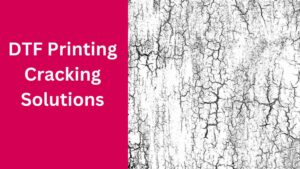Are you frustrated with DTF print cracking and ruining your designs? It’s not just you. DTF Printing can lead to print cracking, in which the ink layer splits and leaves ugly lines or holes in the pattern. This can be an irritating and expensive problem for both organisations and people, particularly when it results in lost time, money, and materials. But don’t worry; in this blog article, we’ll explain how to stop t-shirt print from cracking so you always have crisp, long-lasting prints.

What is DTF print cracking?
DTF (Direct to Film) print cracking occurs when the ink film breaks, leaving lines or holes in the pattern. This issue may arise with DTF transfers and DTF direct-to-garment (DTG) printing, among other forms of digital printing.
DTF print cracking has a variety of potential reasons. Different ink formulations have various adhesion qualities and may adhere poorly with the substrate. In addition, elements including substrate type, curing temperature, and curing duration might impact the ink film’s adherence and endurance.
For instance, the ink will not adhere effectively and may crack or peel off if the you do not clean the substrate properly or prepare before printing. If the curing temperature is too low or time is too short, the ink may not properly bond with the substrate and shatter under stress.
Why is My DTF Print Cracking?
What causes DTF to crack? Many circumstances may lead to this situation, including:
- Ink type: The adhesion qualities of various ink formulations vary, and some may not adhere well with certain surfaces. For instance, certain DTF inks may not cling well to polyester materials, which might result in peeling or splitting.
- Substrate: The surface that the ink is printed on is referred to as the substrate. Ink may break or peel if you don’t clean the substrate thoroughly before printing. If the substrate is overly hard or elastic, printing tension may shatter or damage it.
- Curing temperature and time: We heat the printed substrate to a certain temperature and time to adhere the ink to the substrate. The ink may not entirely bind with the substrate if the curing temperature is too low or the curing period is too short .As a result, the ink may break or split under stress.
- Ink thickness and application: Incorrect ink thickness or application can potentially cause DTF print breaking. For instance, if the ink is placed unevenly or too thickly, it will dry correctly and result in cracking or other flaws.
- Environmental factors: Humidity, UV radiation, and severe temperatures may also impair DTF print adherence and durability, causing cracking or other problems.
How to prevent DTF print cracking?

Following these advice and recommended practises can help you avoid DTF (Direct to Film) print cracking:
- Choose the correct ink: Various inks have different adhesion characteristics, and some may not adhere well with certain surfaces. Be sure the ink you choose is appropriate for the particular substrate on which you are printing.
- Prepare and clean the substrate before printing. This will enhance adherence and stop the ink from peeling or splitting.
- You should made an adjustment to the curing temperature and duration depending on the ink and substrate. For best results, follow the manufacturer’s recommendations and utilise a calibrated curing oven or heat press.
- Choose the proper substrate: Making the right substrate choice is essential for avoiding DTF print cracking. Ensure sure the substrate is acceptable for printing and has the right amount of stretch and stiffness to sustain printing pressure.
- Apply ink uniformly and at the right thickness: The prevention of cracking depends on good ink distribution. Avoid applying too much or too little ink and make sure you apply the ink evenly and at the right thickness.
- Employ top-notch tools and supplies: Utilizing top-notch tools and supplies may aid in preventing DTF print cracking. This involves using a top-notch substrate, printer, ink, and curing oven, as well as a trustworthy heat press.
By using these recommendations, you may drastically lower the possibility of DTF prints cracking and produce flawless, high-quality prints. However, if you have already a garment that has DTF prints cracking, here’s how you can fix those cracks:
How to fix DTF print cracking?
Repairing DTF (Direct to Film) print cracking may be difficult, but there are numerous ways to fix and avoid it. Here are some options to reduce cracking on garments:
- Put a protective coating: Coating the damaged region with a protective coating is one way to repair DTF print cracking. This can offer additional protection against wear and strain and help stop future cracking. Clear films and sprays are only two examples of the various protective coatings that you can use to cover prints.
- Try a different kind of ink: If the cracking is due to an ink problem, trying a different kind of ink might help to solve the issue. If inadequate adhesion causes cracking, switching to a new ink with greater adhesion may improve the binding between the ink and substrate.
- Alter the curing process: If improper curing is to blame for the cracking, changing the curing temperature and duration can improve in resolving the issue. This can include raising the temperature, lengthening the curing period, or, if employing a heat press, modifying the pressure. To get the greatest results, it’s crucial to follow the manufacturer’s curing instructions.
- Employ a different substrate: If the substrate is the cause of the cracking, it might be required to use a different kind of substrate. Switching to a substrate with more stiffness helps avoid cracks caused by overstretching.
- Speak with a specialist: If you are having trouble resolving DTF print cracking on your own, seeking professional advice can be beneficial. An expert printer or technician can offer suggestions and direction on the finest options for your particular circumstance.
Does DTF Print Crack?
Yes, printing on DTF (Direct to Film) may break under specific circumstances. Cracking can happen by a variety of elements, including the ink type, substrate, and curing temperature. It can happen if the ink is not well bonded to the substrate, if the substrate is stretched too much or is not fully cured.
With correct ink and substrate selection, curing temperature and time, and preventive measures like a protective coating, you can make DTF printing cracked-free. Hence, although cracking with DTF printing is a possibility, we can avoid it with the right approach and caution.
Why is DTF print cracking after wash?
If the ink was not properly dried or the substrate was not handled carefully, DTF (Direct to Film) prints may shatter after washing. Insufficient curing might cause ink to not entirely adhere to the substrate, causing cracking after washing. Cracking can also happen if the substrate wasn’t properly treated before or after printing, or if the fabric wasn’t handled correctly during printing or washing.
Following the manufacturer’s temperature and time requirements for ink curing prevents DTF prints from breaking after washing. Pre-treating the cloth, washing, and drying it correctly are also vital. Protecting the printed pattern with a transparent film or coating may also prevent cracking.
If cracking does happen after washing, you may need to reprint the design using the right techniques.
How to fix cracked print on shirt?
Repairing a shirt with a damaged print is difficult, but there are a few things you may try:
Remove the cracked portion entirely: If the crack is really serious, it could be essential to do so. With a sharp blade or pair of scissors, gently cut off the damaged area of the print. Learn how you can remove DTF prints from the garments.
Cover the hole with a patch: After removing the damaged region, you may repair the hole. Choose a cloth or fabric that goes with the shirt, then cut it to the right size and form. Use fabric glue or a heat press to apply the patch on the shirt.
Cover the crack with a new design: If the crack is minor, you may be able to do so. Make a new design that is a little bigger than the crack and print it with the right ink and printing technique onto transfer paper. Using a heat press, apply the transfer paper to the impacted area.
Use a fabric marker: Use a fabric marker to fill up fractures or imperfections. Carefully fill in the cracked area with a marker that is the same colour as the shirt.
The appropriate equipment and procedures can save a shirt with a cracked print. In ensuring that the repaired region is strong and long-lasting, it is crucial to use the right procedures and exercise caution.
White Cracking (Uneven Whites) on DTF Print
DTF printing often has white cracking, or uneven whites, as the white ink layer cracks or peels away from the substrate. Ink viscosity, substrate preparation, and curing temperature can induce this.
It’s crucial to check that the ink is properly mixed and has the right viscosity for printing if you want to avoid white cracking on DTF prints. The surface should be properly cleaned and free of anything that could get in the way of the ink sticking to it. To ensure that the ink thoroughly adheres to the substrate, follow the manufacturer’s curing temperature and time directions.

How do I stop my DTF print from cracking? There are a few actions you can do to try to retain the print if white cracking does happen:
Reprint the design: Severe white cracking may require reprinting. Ensure sure the ink is correctly blended and has the appropriate viscosity for printing. Prepare the substrate properly and use the right curing temperature and duration.
Use a fixative: If the white cracking is minor, you can treat the affected area with a fixative. Apply DTF print fixative gently to the affected area. This can help to increase adhesion and prevent cracking further.
Use a heat gun: For very small areas of white cracking, you can carefully melt the afflicted region and smooth out any cracks or defects. Use a low heat setting, and be careful not to burn the print’s surrounding areas.
Prevent Fading On DTF
Stopping DTF prints from fading is important if you want the design to stay bright and last a long time. The following advice will help you stop fading on DTF prints:
- Choose high-quality ink: Choosing ink that is high-quality and made especially for DTF printing can assist to prevent fading. Poor-quality ink might not stick to the surface adequately and will deteriorate with time.
- Utilize the proper ink volume: Preventing fading requires using the proper ink volume. A design that has too little ink or too much ink will bleed and fade, respectively. Follow the manufacturer’s ink volume and printer calibration instructions.
- Use the proper curing temperature and duration: These factors are crucial for ensuring that the ink sticks to the substrate completely and prevents fading. Before washing or wearing, follow the manufacturer’s curing time and temperature recommendations.
- Wash the item carefully: DTF prints can withstand fading with careful washing and maintenance. Use cold water to wash the item inside out without bleach or fabric softener. Instead of using a dryer, hang or lay your clothes out.
- Add a clear coat or fixative: A clear coat or fixative can help safeguard the DTF print against fading and wear. Follow the manufacturer’s directions to apply a DTF print-specific clear coat or fixative.
Conclusion
In conclusion, DTF print cracking can be a frustrating problem for any printer, but there are a number of ways to fix it and prevent it from happening. Understanding ink kind, substrate, and curing temperature, as well as the core cause of cracking, is crucial.
By using the right type of ink, adjusting the curing temperature, choosing the right substrate, and taking other precautions, it is possible to make high-quality, long-lasting prints that will please customers and stand the test of time. DTF printing may be a fruitful and profitable business for any printing firm with the correct equipment, information, and troubleshooting skills.
FAQs
No, it’s important to use an ink that is made especially for DTF printing. Use of inferior or mismatched ink might result in problems including peeling, cracking, and fading.
A heat press can cure DTF prints with the right temperature and time settings. To thoroughly bond the ink to the substrate, follow the manufacturer’s curing temperature and time.
To avoid fading and print damage, we advise you to wash DTF prints in cold water. Hot water and bleach may fade or peel prints.
You may need to reprint the design or use a fixative. To stop the cracking from recurring in the future, it is crucial to identify and treat its underlying causes.
Sure, a clear lacquer or fixative may preserve the pattern. Choose a product that is especially made for DTF printing, then apply it according to the directions provided by the manufacturer.

Ashley Wang is a skilled sales manager with knowledge in DTF printing. She presently works for ShenLan Digital, a reputable DTF printer maker. Ashley is the best person to offer advice on selecting the most suitable DTF printer because she has tested a lot of them. She launched DTFPrinterSchool to educate individuals and organizations about DTF printing technology, providing her expertise and observations on the most recent advancements in the sector. Ashley is an invaluable resource for businesses and individuals wishing to invest in DTF printing technology because of her expertise and experience in the industry.
